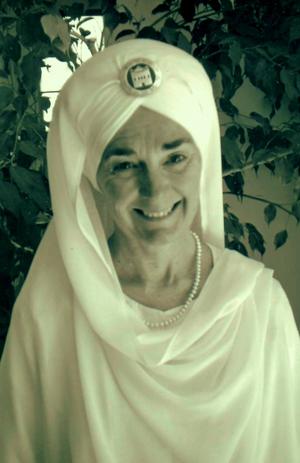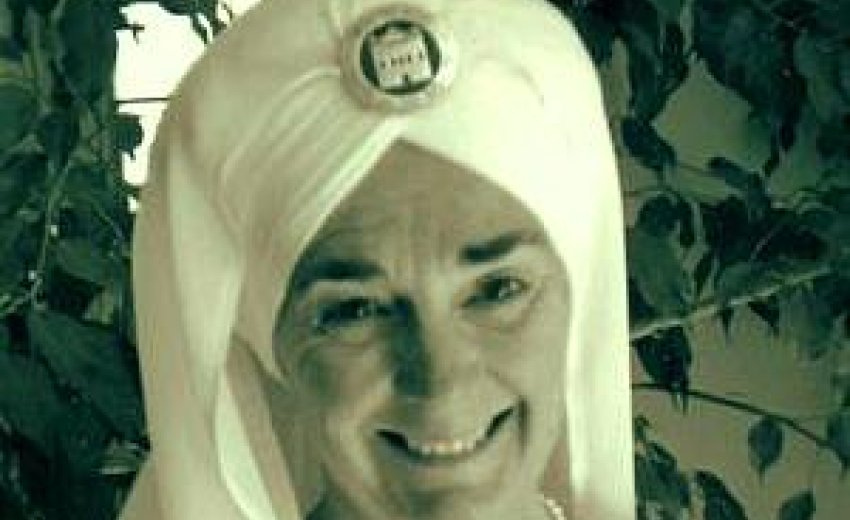“To die is an art. Everything on this planet, every act is done so that dying may be graceful. There’s no dharma, there’s no meditation needed. There is nothing. We can go through the karmas all right. All knowledge of spirituality is to mend one thing only - that when we die, we die in grace, without fear, without vengeance, without desire. We should just love to die, that moment, that meditative moment…at that moment, everything is decided. There is no afterwards. Those who seek afterwards get into the cycle of karma.” - Yogi Bhajan
There are volumes of books in every religion written about the concepts of the afterlife, and especially heaven and hell. Do they exist? What are they like? Who goes there? How do you get there? How can you be sure where you are going? For some, it is a topic of great anticipation and exaltation. Conversely, the thought of them fills others with worry, dread and fear. They are unknown and elusive. Many spend much time and energy in life working toward liberation in the after-world. But, how does one know for sure that their life has been good enough to guarantee them entry into the Kingdom of God?
This article is about another concept of heaven and hell – a yogic concept.
 There is a beautiful Eastern/Yogic concept called Jiwan
Mukht. Jiwan means life, Mukht means
free or liberated. We can achieve
Jiwan-Mukht, liberation while yet alive.
We don’t have to wait until an afterlife to achieve it. It exists for us right now. Expanding upon
that theme, let’s look at its various aspects.
There is a beautiful Eastern/Yogic concept called Jiwan
Mukht. Jiwan means life, Mukht means
free or liberated. We can achieve
Jiwan-Mukht, liberation while yet alive.
We don’t have to wait until an afterlife to achieve it. It exists for us right now. Expanding upon
that theme, let’s look at its various aspects.
The first aspect - Freedom, wisdom and the experience of God or the Infinite Self can be realized while we are still alive. It is not the physical body, but the mind that creates a separation from God, that constitutes human bondage and agony (hell on earth). Our imperfection and suffering in this world is due to our ignorance of our own true nature, our Divine nature. When we are in the most anguish, we have forgotten in the core of our being that we are a piece in the mosaic of all Creation. We disengage from what gives us life and sustenance, that loving, ever-present energy which will never abandon us. Realizing our relationship to our Infinite consciousness or God and experiencing the true nature of the self alleviates this suffering, (heaven on earth).
Remembering our connection to the Source or not will have a profound impact on our consciousness. This brings us to the second aspect of "Jiwan-Mukht." The consciousness in which we live will follow us to death and beyond. In other words, if we are living an honorable, fearless, joyous, God-conscious life on earth, we will carry that state with us when we die. If we are fearful, guilt-ridden or angry, we will bring that state with us to death. The consciousness in which we live is the same in which we die.
“A state of fearlessness is the highest state. That is why Guru Nanak referred to God as NIRBHAO - without fear. Folks, there is no death. Death is what? Going home. …A fearless mind is the highest state of consciousness, because when the mind is fearless then you can go home. Otherwise, you are homeless. If you can develop your mind through the creativity of your experience - that you can experience fearlessness – death will not mean a thing to you. When death doesn’t mean anything, you become deathless.”
- Yogi Bhajan
Fear binds us to our senses, passions and ego - finite shackles, which unfortunately are all too familiar to us, because we can feel them. They somehow remind us that we are alive. The down side is that as they are ego based, propelled by our smallness, they thus create pain…instead of spirit based propelled by our greatness, creating expansion.
Some of our greatest failures in life are the result of our expectations or illusions of what we desire, perhaps originating from a childhood fantasy or our parent’s unfulfilled dreams. These attachments thwart our opportunities - like being confined in a box with no openings - we can’t see beyond our self-imposed prison. Conversely, living fearlessly means surrendering to what is. It allows us to flow with the creativity of the Master Planner, expanding us to limitless possibilities (heaven).
I am reminded of a member of my spiritual community who, unhappy in his marriage, went to Yogi Bhajan for counsel. Yogi Bhajan told him that he was consumed with his fantasy about what he thought marriage should be. He gave the man a special meditation to do for forty days, telling him that happiness would come if he could drop his illusions of the past, accept what is and build on the positives. Today, this man’s marriage is thriving. His personal motto in all areas of his life has become – “Accept what is and build on the positives,” (heaven).
Living fearlessly does not mean that there is a negation of the mind, our will and the senses; in fact, we can develop them to be functioning in an acute state of awareness, while maintaining equilibrium and harmony - thus aiding fearlessness. Through a daily spiritual practice, our negative ego and passions can be transcended into our true nature, orchestrated by a finely tuned intuition, ending our seemingly endless karma of pain and suffering. We will be living fearlessly…and thus joyously - we will become deathless.
“Death is a process where your consciousness does not exist within the control of your ego.” - Yogi Bhajan
When living from our ego consciousness, instead of our God consciousness, most of the time our energy is constantly fluctuating, rising and falling between heaven and hell. Satisfying our desires, we think we are in heaven. Blocked from gratification, we drop to hell. We don’t realize that hell is resistance…struggle, while heaven is acceptance… surrender. Hell is the tense jaw of “Me ness.” Heaven is the expanded “We ness” of the heart, when we dare to reach out and unconditionally love. Our mood and energy swings often reflect an imbalance in the Chakras. For example, a block in the lower three Chakras may result in emotions of fear, guilt and revenge – living hell. The greatest harmony, balance and benefit come when the energy moves in a rhythmic flow up and down the Chakras. Kundalini Yoga is our tool to manage our own Chakra balance and therefore forklift our own energy and consciousness – living in heaven.
There is a story of a great Samurai who comes to visit the Zen master, Hakuin. The Samurai approaches the Zen master and bows dutifully, asking, “Sir, I wish to understand the differences between heaven and hell.” The Zen master looks at the Samurai and, eying him from head to toe, says, “I would tell you, but I doubt that you have the keenness of wit to understand.” The Samurai pulls back in astonishment. “Do you know to whom you are speaking?” he huffs. “Not much," says the Zen master, "I really think you are probably too dull to understand.” “What?” says the Samurai. “How can you talk to me like this?” “Oh, don't be silly,” says the Zen master. “Who do you think you are? And that thing hanging by your waist, you call that a sword? It's more like a butter knife.” The Samurai, becoming enraged, draws his sword and raises it over his head to strike the Zen master. “Ah," says the Zen master. “That is hell.” The Samurai's eyes shine with recognition as his heart opens and he bows low, sheathing his sword. “Now that,” says the Zen master, “is heaven.”
Forgiveness is a key to happiness (heaven on earth). Without it we will be in an unending spiral of pain and living hell. Remembering back to Chapter One – God Exists Within Us - we first talked about the “divine trinity” - your Creator, the Guru within you (your own intrinsic inner wisdom) and you. All of us are this trinity. There is no difference, no separation between us. If we can live in this trinity, seeing the God in all - seeing God in each other and ourselves - forgiveness will prevail. We will be able to forgive others and ourselves. We will live as God’s children. A good meditation for forgiveness can be found at the end of this article - Meditation to Conquer Self-Animosity.
“God has given you everything. If you want to give something, give forgiveness. First forgive yourself. Then forgive your environments, and then forgive all those whom you cannot forgive. That is the beginning of greatness of character.” - Yogi Bhajan
A dear friend of mine, Sat Jiwan Singh Khalsa, the Director of the Manhattan Yoga Center, poignantly describes his experience participating in a prayer service at “Ground Zero,” the site of the September 11, 2001 World Trade Center disaster, and in so doing gives us a graphic example of God’s love and Union between his children amongst intolerable suffering.
“For an extremely brief moment the thought passed through my mind that maybe an enchanted fog had descended over the towers rendering them invisible, but I caught myself. I felt my chest tighten. This was not a fairy tale; there was nothing enchanted here- no sorcerers, no spells, and definitely no invisible towers, just mind-numbing, heart-wrenching reality.
I finished praying and stepped off the stage. An extremely large fireman in full gear was looking at me. He approached to within a foot or two of me, looked at me, and sweetly said, ‘Can I have a hug?’ And then he gave me a fantastic hug. It was wonderful. He was a chaplain from the Chicago Fire Department…And then he asked, ‘Can I have another hug?’ What an amazing man of God, of love, and of peace in the midst of hell. A real hero!
He inspired me. And God inspired me. I believe this experience to be a metaphor for what we need to be doing now - healing each other with heart-to-heart contact. Prayer is a great healer. But now, more than ever, I think we also really need heartfelt, loving contact. Just as the fireman did for me, we should all be ready to rescue those in need. We can all be heroes if we can overcome our shyness and our fear and step out and touch someone. Let the hand of God work for you like it worked for me. And let the love flow - we can all use it.”
(Aquarian Times Magazine, Volume 1, Number 4, Winter 2001, P.10.)
This leads us right into the third aspect of Jiwan-Mukht. Life is not today and death tomorrow. Both exist right now. We can either say “yes” or “no” to life. Each of us must ask the question, am I living or am I dying?
What does this all mean, saying “yes” or “no” to life? Take a moment to think about it. When have you felt really open and alive? Imagine a particular incident and consider how it affected you. What did your body look like? How did you move? Did your voice have a certain quality to it? How was your breathing? What were your thoughts? What were you feeling inside? Consider all of your sensations and ponder over them. Were you feeling good about yourself? Did it affect your behavior? Then, do the same process when you were feeling constricted or dead. Which state felt better? Which took more or less energy? It’s all our choice. We can say “no” to life, allowing a part of us to wither away and die. Or we can say “yes,” allowing life to expand us.
“Butterflies count not in months but in moments and have time enough.” - Rabindranath Tagore
Saying yes to life means taking risks. It means daring to try something new, to be different. Have you ever heard someone say, “I'm too old to try that” or “That's a bad idea, it will never work.” Isn’t it really their minds that have shriveled into atrophy? They constrict, not allowing the impossible to become possible. Have you ever seen a parent tell a child their idea was impossible, and then the child made it happen? Who is dead in that case? I know an eighty-five year old woman who refuses to allow death to catch her. She volunteers with “Meals On Wheels,” teaches tap dancing at the community college, plays golf with lady friends and takes long walks on the beach with her dog. Her attitude is positive, enjoying every moment of life. She jokes that she wants to die with her tap shoes on. Her friend sits home, watching TV all day, worrying that she is going to die soon. On some level, she has already died.
Starting right this moment say, “yes” to something in your life you’ve said “no” to before. Take some deep breaths, letting that life force fill you. As you exhale, let go of your fear and hesitation. Start small, saying, “yes” to little things. Gradually build up to bigger and more significant things. When my husband was 49 years old, he learned how to white water kayak. With his long white beard, his much younger kayak buddies call him “River Daddy.” When he’s on the river, he’s in heaven.
Saying “yes” to life also means allowing parts of us to die. It means letting go of old or negative habits, ideas and thoughts, which may not serve us any longer. They may have served a previous purpose, which is no longer, a part of our reality. Let them go, let them die. When we are able to do this, a vacuum is created, making room for the birth of new ideas and habits, which may be more appropriate to our present situation. Each day is a new beginning, a rebirth and each night is a closing or release. In this way, life can be an exciting journey, taking in and letting go, living it to the fullest, until our very last breath. All of life becomes a natural flow of life and death. Two meditations at the end of the article - Ten Steps to Peace and Clearing the Emotions of the Past will help you clear the past, allowing for the new to emerge.)
“This isn’t what I expected it to be. This is all new, because my expectations about me being old didn’t have this stroke in it. The suffering comes when you try to hold on to continuity - like things I can’t do. I can’t shift my car. I got a new car before I stroked. And now I get into that car in the seat next to the driver. My attendant drives the car. And, I can either be a driver, which is going to make me suffer on that trip, or I can be somebody who is chauffeured.” - Ram Das speaks in the movie Fierce Grace
NOTE: Part II of this article will be published here later this week.

